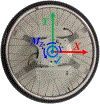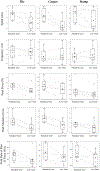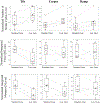Hand-rim biomechanics during geared manual wheelchair propulsion over different ground conditions in individuals with spinal cord injury
- PMID: 35947887
- PMCID: PMC10765479
- DOI: 10.1016/j.jbiomech.2022.111235
Hand-rim biomechanics during geared manual wheelchair propulsion over different ground conditions in individuals with spinal cord injury
Abstract
Geared manual wheelchair wheels, a recently developed alternative propulsion mechanism, have the potential to alleviate the high upper extremity demands required for wheelchair propulsion and help decrease the risk of secondary injuries in manual wheelchair users. The objective of this study was to investigate the effects of using geared manual wheelchairs on hand-rim biomechanics of wheelchair propulsion in individuals with spinal cord injury (SCI). Seven manual wheelchair users with SCI propelled their wheelchairs equipped with geared wheels over tile, carpet, and up a ramp in low gear (gear ratio 1.5:1) and standard gear (gear ratio 1:1) conditions. Hand-rim kinetics and stroke cycle characteristics were measured using a custom instrumented geared wheel. Using the geared wheels in the low gear condition, propulsion speed (P = 0.013), peak resultant force (P = 0.005), peak propulsive moment (P < 0.006), and peak rate of rise of the resultant force (P = 0.035) decreased significantly in comparison with the standard gear condition. The significant increase in the number of stroke cycles when normalized to distance (P = 0.004) and decrease in the normalized integrated moment (P = 0.030) indicated that although a higher number of stroke cycles are required for travelling a given distance in the low gear than the standard gear condition, the low gear condition might be less demanding for the upper extremity. These results suggest that geared wheels could be a useful technology for manual wheelchair users to independently accomplish strenuous propulsion tasks including mobility on carpeted floors and ramp ascension, while reducing the risk factors contributing to the incidence of secondary upper extremity injuries.
Keywords: Alternative propulsion mechanism; Biomechanics; Hand-rim kinetics; Manual wheelchair; Upper extremity.
Copyright © 2022 Elsevier Ltd. All rights reserved.
Conflict of interest statement
Declaration of Competing Interest The authors declare the following financial interests/personal relationships which may be considered as potential competing interests: Elizabeth Hsiao-Wecksler is a co-founder of IntelliWheels, Inc., the manufacturer of the geared manual wheelchair wheels that were used in this study. IntelliWheels, Inc. was sold in July 2018 and Dr. Hsiao-Wecksler is no longer involved in the company.
Figures



Similar articles
-
Glenohumeral joint dynamics and shoulder muscle activity during geared manual wheelchair propulsion on carpeted floor in individuals with spinal cord injury.J Electromyogr Kinesiol. 2022 Feb;62:102318. doi: 10.1016/j.jelekin.2019.05.019. Epub 2019 May 31. J Electromyogr Kinesiol. 2022. PMID: 31178393 Free PMC article.
-
A comparison of glenohumeral joint kinematics and muscle activation during standard and geared manual wheelchair mobility.Med Eng Phys. 2019 Aug;70:1-8. doi: 10.1016/j.medengphy.2019.06.018. Epub 2019 Jul 5. Med Eng Phys. 2019. PMID: 31285137 Free PMC article.
-
Use of a geared wheelchair wheel to reduce propulsive muscular demand during ramp ascent: analysis of muscle activation and kinematics.Clin Biomech (Bristol). 2010 Jan;25(1):21-8. doi: 10.1016/j.clinbiomech.2009.10.004. Clin Biomech (Bristol). 2010. PMID: 19880226
-
Wheelchair propulsion biomechanics and wheelers' quality of life: an exploratory review.Disabil Rehabil Assist Technol. 2011;6(5):365-77. doi: 10.3109/17483107.2010.525290. Epub 2010 Oct 11. Disabil Rehabil Assist Technol. 2011. PMID: 20932232 Review.
-
Biomechanics and physiology in active manual wheelchair propulsion.Med Eng Phys. 2001 Dec;23(10):713-33. doi: 10.1016/s1350-4533(01)00083-2. Med Eng Phys. 2001. PMID: 11801413 Review.
Cited by
-
A semi-structured interview to capture manual wheelchair use for mobility activities among individuals with spinal cord injury in real-life situations: development and content validity of the Wheelchair Mobility Activity Log (WC-MAL).Spinal Cord. 2024 Aug;62(8):468-478. doi: 10.1038/s41393-024-01011-7. Epub 2024 Jun 21. Spinal Cord. 2024. PMID: 38907085
-
Systematic Review of Usability Tests for Manual Wheelchairs: Enhancing Mobility and Reducing Shoulder Injuries in Individuals with Spinal Cord Injuries.J Clin Med. 2025 May 4;14(9):3184. doi: 10.3390/jcm14093184. J Clin Med. 2025. PMID: 40364215 Free PMC article. Review.
-
Development and Evaluation of a 3D Motion Capture Model for Upper Extremity Kinematics During Wheelchair Maneuvering in Individuals with Spinal Cord Injuries: A Pilot Study.Bioengineering (Basel). 2025 Jun 12;12(6):648. doi: 10.3390/bioengineering12060648. Bioengineering (Basel). 2025. PMID: 40564464 Free PMC article.
References
-
- Boninger ML, Baldwin M, Cooper RA, Koontz A, Chan L, 2000. Manual wheelchair pushrim biomechanics and axle position. Archives of physical medicine and rehabilitation 81, 608–613. - PubMed
-
- Boninger ML, Cooper RA, Baldwin MA, Shimada SD, Koontz A, 1999. Wheelchair pushrim kinetics: body weight and median nerve function. Archives of physical medicine and rehabilitation 80, 910–915. - PubMed
-
- Boninger ML, Koontz AM, Sisto SA, Dyson-Hudson TA, Chang M, Price R, Cooper RA, 2005. Pushrim biomechanics and injury prevention in spinal cord injury: recommendations based on CULP-SCI investigations. Journal of rehabilitation research and development 42, 9. - PubMed
-
- Curtis K, Roach K, Applegate EB, Amar T, Benbow C, Genecco T, Gualano J, 1995. Development of the wheelchair user's shoulder pain index (WUSPI). Spinal Cord 33, 290–293. - PubMed
Publication types
MeSH terms
Grants and funding
LinkOut - more resources
Full Text Sources
Medical

